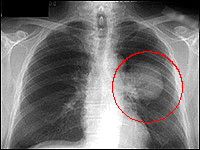 |
| Xray image of lung cancer |
Lifestyle issues that might influence stroke risk -- such as smoking, drinking or diet -- were not factored in, said Fung-Chang Sung, senior author of the study, which was published in the journal Stroke.
Couse of cancer
| Type of Cancer | Risk factors |
|---|---|
| lung cancer | cigarette smoking; exposure to asbestos, uranium and nickel |
| skin cancer | excessive exposure to the sun, tanning salons |
| breast cancer | familial history - genetics |
| cervix cancer | human papilloma virus exposure |
| colon and rectum | high fat diet, low fiber |
| oral cancer | alcohol plus smoking, smokeless tobacco |
| urinary bladder | aniline dye exposure, cigarette smoking, exposure to parasite Schistosoma haematobium |
| leukemia | exposure to benzene, ionizing radiation |
Still, the risk was highest during the first three months after a lung cancer diagnosis for men and during the first four-to-six months for women.
"Lung cancer is associated with increased risk of subsequent stroke within one year after diagnosis for men and two years after diagnosis for women," Sung and colleagues wrote, adding that the risk subsequently decreased after that period of time.
Chart below show us the % of mortality of cancer patient:
| Cancer Type | Estimated New Cases | Estimated Deaths | Percent Mortality |
|---|---|---|---|
| Skin (non-melanoma) | >1,000,000 | <1,000 | 0.1% |
| Lung (Including Bronchus) | 215,020 | 161,840 | 75% |
| Prostate | 186,320 | 28,660 | 15% |
| Breast (Female) | 182,460 | 40,480 | 22% |
| Colon and Rectal (Combined) | 148,810 | 49,960 | 34% |
| Bladder | 68,810 | 14,100 | 20% |
| Non-Hodgkin Lymphoma | 66,120 | 19,160 | 29% |
| Melanoma | 62,480 | 8,420 | 13% |
| Kidney (Renal Cell) Cancer | 46,232 | 11,059 | 24% |
| Leukemia (All) | 44,270 | 21,710 | 49% |
| Endometrial | 40,100 | 7,470 | 19% |
| Pancreatic | 37,680 | 34,290 | 91% |
| Thyroid | 37,340 | 1,590 | 4% |
The researchers also found that a less common type of stroke -- hemorrhagic stroke, caused by sudden bleeding into the brain -- occurred more often among the lung cancer patients than ischemic stroke, which is usually caused by a clot blocking blood flow to brain tissue.
Some evidence suggests that excessive bleeding and blood clots, both of which can be caused by tumours, as well as chemotherapy side effects, could partly explain the apparent link between cancer and stroke, researchers note.
"The most common type of lung cancer, adenocarcinoma, increases the body's propensity to form blood clots, even more so than other types of cancer," said Andrew Russman, a stroke specialist at the Henry Ford Hospital in Detroit, who was not a part of the study.
More than 52,000 people with lung cancer and more than 104,000 people without lung cancer were selected from a nationwide health insurance database.
Most of the study population was blue-collar workers such as farmers, fishermen and vendors, who tended to have high blood pressure, diabetes and heart disease.
"There's a higher rate of high blood pressure and diabetes and pulmonary disease in patients with lung cancer," Russman said.
 |
| what's up doc |
"I think this reflects the heavy burden of smoking and smoking-related risk factors in the population."
According to the American Lung Association, smoking is directly responsible for approximately 90 percent of lung cancer deaths, while the American Heart Association said in a report that strokes accounted for one of out eighteen deaths in the United States in 2007.
"In the U.S., smokers have twice the risk of having a stroke, regardless of lung cancer," Russman said.
No comments:
Post a Comment